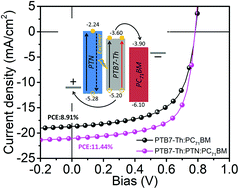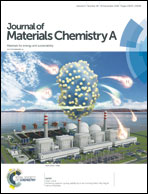Excimer emission induced intra-system self-absorption enhancement – a novel strategy to realize high efficiency and excellent stability ternary organic solar cells processed in green solvents†
Abstract
A novel diphenylimidazole derivative (PTN), which shows strong excimer emission, has been designed and utilized in organic solar cells (OSCs). The extended solid-state excimer emission facilitates intra-system self-absorption and accelerates photon trapping in OSCs. The ternary OSC based on PTB7-Th:PTN:PC71BM using a green solvent (ethylbenzene) exhibits a high PCE of 11.44%, which is 28.40% higher than that of the binary device (8.91%). The great enhancement is mainly ascribed to the increased self-absorption in the system. Furthermore, the well-organized stacking of PTN is beneficial to promote overlap between small molecules and polymers and then accelerates intermolecular energy transfer. The most important thing to note is that ternary OSCs fabricated both with halogen and nonhalogen solvents show better air, thermal and light irradiation stability, compared with the control device. Over 55 days of air storage, the PCE of the unpackaged ternary OSC still remains at 76%, whereas the control device becomes inefficient. The performance is among the best results for both efficiency and stability in PTB7-Th:PC71BM based solar cells, which can narrow the gap between laboratory investigations and industrial production.



 Please wait while we load your content...
Please wait while we load your content...